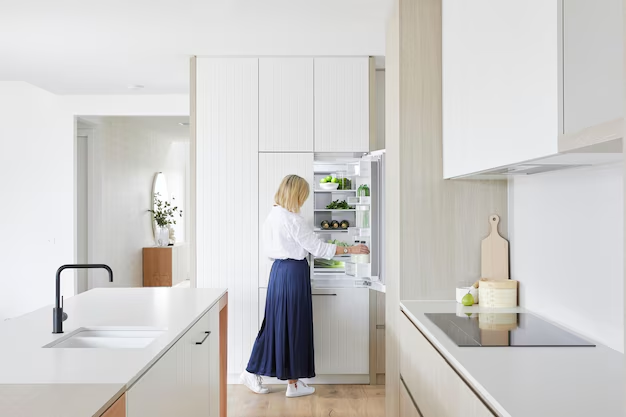What You Need to Know About Refrigerator Sizes: Finding the Right Fit for Your Kitchen
In today's fast-paced world, the refrigerator has become an essential household appliance. But with so many options available, finding the right size can be more complicated than you might think. Whether you're moving into a new home or simply upgrading your kitchen, understanding what constitutes a "regular" refrigerator size is crucial. This guide will provide you with everything you need to know to make an informed decision.
🧊 Understanding Standard Refrigerator Sizes
Typical Dimensions
The term "regular" refrigerator can mean different things to different people, especially when you consider the variety of kitchen layouts and family needs. However, most standard refrigerators fall into these general size categories:
- Top-Freezer Refrigerators: These models are classic and quite popular. They typically measure 28 to 33 inches wide, 60 to 69 inches tall, and 28 to 34 inches deep.
- Bottom-Freezer Refrigerators: Offering easier access to fresh foods, these are somewhat similar in size to their top-freezer counterparts. They measure approximately 29 to 33 inches wide, 67 to 70 inches tall, and 33 to 35 inches deep.
- Side-by-Side Refrigerators: Ideal for those who require more freezer space, these models range from 32 to 36 inches in width, 65 to 70 inches in height, and 30 to 34 inches in depth.
- French Door Refrigerators: Known for their spacious interiors, these generally measure 29 to 36 inches wide, 68 to 70 inches tall, and 29 to 34 inches deep.
Internal Capacity
The capacity of a refrigerator is typically measured in cubic feet, and it's an important indicator of how much food you can store. For a standard household, here are some typical capacities:
- Top-Freezer Models: Usually offer 16 to 22 cubic feet of internal space.
- Bottom-Freezer Models: Provide around 19 to 24 cubic feet.
- Side-by-Side Models: Range from 20 to 28 cubic feet.
- French Door Models: Often provide between 20 and 30 cubic feet.
Measuring for Fit
Before making a decision, it's vital to ensure that your new refrigerator will fit your kitchen space. Here are some handy measuring tips:
- Width, Height, and Depth: Measure in multiple locations to account for any uneven walls or counter height.
- Leave Space for Ventilation: Most manufacturers suggest leaving at least 1 inch of space on the sides and back.
- Consider the Door Swing: Ensure there is enough space for doors to open fully without hitting walls or cabinets.
- Check Pathways: Measure doorways, stairwells, and other entrances to ensure the refrigerator can be moved into your kitchen.
Quick Checklist 📝
- Width: 28 - 36 inches
- Height: 60 - 70 inches
- Depth: 28 - 36 inches
- Capacity: 16 - 30 cubic feet
Suitability for Your Lifestyle
Family Size and Lifestyle Considerations
Choosing the right refrigerator also depends on your family size, lifestyle, and eating habits:
- Small Families/Couples: A top or bottom-freezer model is usually sufficient.
- Larger Families: French door models provide ample space and organizational options.
- Entertainers: Side-by-side or larger French door models are ideal for those who host frequently and need extra space for platters and beverages.
- Eco-conscious Shoppers: Look for models with energy-efficient features and ratings to reduce your carbon footprint.
Making Your Decision
Features That Matter
Today's refrigerators come with various features designed to make life easier and more efficient. Here are some to consider:
- Adjustable Shelves: Allow customization of internal space to fit odd-shaped items.
- Ice and Water Dispenser: Perfect for families who need quick access to chilled water and ice.
- Smart Technology: With some models offering Wi-Fi connectivity, you can check contents remotely or even create a grocery list.
- Humidity-Controlled Drawers: Help keep fruits and vegetables fresh for longer.
- Door-In-Door Access: Convenient for grabbing frequently used items without opening the entire fridge.
Energy Efficiency and Cost
Refrigerators can account for a significant portion of your home's energy usage. Therefore, selecting an energy-efficient model not only saves on your electricity bill but is also better for the environment. Check for:
- Energy Star Ratings: Indicate models that meet certain efficiency criteria.
- LED Lighting: Uses less energy and has a longer lifespan compared to traditional bulbs.
- Inverter Compressors: Adjust cooling power based on necessity, leading to lower power consumption.
Practical Considerations 📌
- Assess Your Needs: Think about your shopping and cooking habits.
- Budget: More features often mean higher costs.
- Space: Don’t forget to measure—consider the entire path from store to kitchen.
- Energy Use: Balance upfront cost with long-term savings from energy efficiency.
Summary Table: Choosing Your Refrigerator
| Type | Width (inches) | Height (inches) | Depth (inches) | Capacity (cubic feet) | Best For |
|---|---|---|---|---|---|
| Top-Freezer | 28-33 | 60-69 | 28-34 | 16-22 | Singles, couples, small families |
| Bottom-Freezer | 29-33 | 67-70 | 33-35 | 19-24 | Standard family needs |
| Side-by-Side | 32-36 | 65-70 | 30-34 | 20-28 | Families with frequent freezer use |
| French Door | 29-36 | 68-70 | 29-34 | 20-30 | Large families, entertainers |
Final Insight: Finding Balance and Fit
Choosing the right refrigerator involves balancing size, style, and function to meet your lifestyle needs. From carefully measuring your kitchen to considering your family's eating habits, these insights provide a comprehensive guide in making the best selection. Prioritize the features most important to you, and keep an eye on energy efficiency to make a choice that fits both your home and your budget for years to come. 😊
